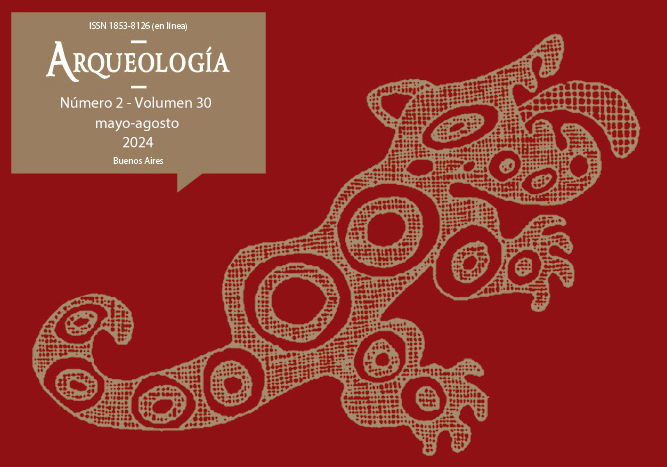Archaeology of Mental Health. Materiality, Space Utilization, and Social Practices in Mental Health Facilities in Chile from the Late 19th Century to the Present
Downloads
References
Brandão Moreira, J. (2015). Arquitetura que enlouquece: Poder e Arqueologia (Tesis de Maestría inédita). Universidade Federal de Minas Gerais, Brasil. http://hdl.handle.net/1843/BUBD-A4UFTP
Brandão Moreira, J. (2017). Arquitetura da loucura: uma leitura arqueológica do Hospital de Neuropsiquiatria Infantil (Belo Horizonte - MG). Cadernos De História Da Ciência, 13(1), 27-55. https://doi.org/10.47692/cadhistcienc.2017.v13.33850
Brandão Moreira, J. (2021). Arqueologia da loucura: narrativas alternativas, cultura material e história do Hospital Colônia de Barbacena (Tesis de Doctorado inédita). Universidade Federal de Minas Gerais, Brasil. http://hdl.handle.net/1843/45725
Casella, E. (2001). Every Procurable Object: A Functional Analysis of the Ross Factory Archaeological Collection. Australasian Historical Archaeology, 19, 25-38. https://www.jstor.org/stable/29544465
Casella, E. (2002). Archaeology of the Ross Female Factory: Female Incarceration in Van Diemen's Land, Australia. Tasmania: Records of the Queen Victoria Museum, Volume 108. Report prepared for the Cultural Heritage Branch (DPIWE, Tasmania). Queen Victoria Museum and Art Gallery and the Tasmanian Wool Centre of Ross
Fennelly, K. (2014). Out of sound, out of mind: noise control in early nineteenth-century lunatic asylums in England and Ireland. World Archaeology, 46(3), 416-430. https://doi.org/10.1080/00438243.2014.909098
Fennelly, K. (2018). The Bedford Asylum: Building for the ‘Industrious Child’ in Early-Nineteenth Century Dublin. En J. E: Baxter y M. A. B. Elis (Eds.), Nineteenth century childhoods in interdisciplinary and international perspectives. Childhood in the Past (pp. 153-165). Oxford: Oxbow Books. https://doi.org/10.2307/j.ctvh1dh7v.15
Fennelly, K. (2019). An archaeology of lunacy. Managing madness in early nineteenth-century asylum. Manchester: Manchester University Press.
Funari, P. P. A. y Zarankin, A. (2003). Social archaeology of housing from a Latin American perspective: A case study. Journal of Social Archaeology, 3(1), 23-45. https://doi.org/10.1177/1469605303003001097
Goffman, E. (2001). Internados. Ensayo sobre la situación social de los enfermos mentales. Buenos Aires: Amorrortu editores.
Hillier B. y Hanson J. (1984). The Social Logic of Space. Cambridge: Cambridge University.
Lightfoot, K. G. (1995). Culture Contact Studies: Redefining the Relationship between Prehistoric and Historical Archaeology. American Antiquity, 60(2), 199-217. https://doi.org/10.2307/282137
Mañana Borrazás, P., Blanco Rotea, R. y Ayán Vila, X. (2002). Arqueotectura 1: Bases Teórico-Metodológicas para una Arqueología de la Arquitectura. Santiago de Compostela: Traballos de Arqueoloxía e Patrimonio (TAPA), 25. Laboratorio de Patrimonio, Paleoambiente e Paisaxe, nstituto de Investigacións Tecnolóxicas, Universidad de Santiago de Compostela. http://hdl.handle.net/10261/6027
Markus, T. (1993). Buildings & Power: Freedom and Control in the Origin of Modern Building Types. Londres y Nueva York: Routledge.
Moshenska, G. y Myers, A. (2011). An introduction to archaeologies of internment. En A. Myers y G. Moshenska (Eds.), Archaeologies of Internment. One World Archaeology (pp. 1-19). New York: Springer. https://doi.org/10.1007/978-1-4419-9666-4_1
Nuevo-Delaunay, A.y Letelier Cosmelli, J. (2024). Americas, South: Historical Archaeology. En T. Rehren y E. Nikita (Eds.), Encyclopedia of Archaeology (2nd Edition, Vol. 3, pp. 641-648). Londres: Academic Press. https://dx.doi.org/10.1016/B978-0-323-90799-6.00074-4
Orser, C. (2006). The Archaeologies of Recent History: Historical, Post-Medieval, and Modern World. En J. Bintliff (ed.), A Companion to Archaeology (pp. 272-290). Oxford: Blackwell.
Piddock, S. (2001a). Convicts and the Free: Nineteenth-century lunatic asylums in South Australia and Tasmania (1830-1883). Australasian Historical Archaeology, 19, 84-96. https://www.jstor.org/stable/29544470
Piddock, S. (2001b). An Irregular and Inconvenient Pile of Buildings: The Destitute Asylum of Adelaide, South Australia and the English Workhouse. International Journal of Historical Archaeology, 5, 73-95. https://doi.org/10.1023/A:1009597226492
Piddock, S. (2004). Possibilities and realities: SouthAustralia's asylums in the 19th century. Australasian Psychiatry, 12(2), 172-175. https://doi.org/10.1080/j.1039-8562.2004.02089.x
Piddock, S. (2007). A Space of Their Own: The Archaeology of Nineteenth Century Lunatic Asylums in Britain, South Australia, and Tasmania. Nueva York: Springer.
Piddock, S. (2009). John Conolly's 'Ideal' asylum and provisions for the insane in nineteenth-century South Australia and Tasmania. En A. M. Beisaw y J. G. Gibb (Eds.), The archaeology of institutional life (pp.187-205). Tuscaloosa: University of Alabama
Rathje, W. (1996). The Garbage Project & “The Archaeology of Us”. En I. Ciegelski (Ed.), Encyclopedia. Britannica's Yearbook of Science and the Future (pp. 158-177). Nueva York: Encyclopaedia Britannica.
Schiffer, M. (1988). ¿Existe una “premisa de Pompeya” en arqueología? Boletín de Antropología Americana, 18, 5-31.
Scull, A. (1989). Social Order/Mental Disorder: Anglo-American Psychiatry in Historical Perspective. Berkeley: University of California Press. http://ark.cdlib.org/ark:/13030/ft9r29p2x5/
Copyright (c) 2024 Javiera Letelier Cosmelli

This work is licensed under a Creative Commons Attribution-NonCommercial-ShareAlike 4.0 International License.
Authors who publish in this journal agree to the following conditions:
- Authors retain copyright and yield to the journal right of first publication with the work registered with attribution license Creative Commons, which allows third parties to use the published always mentioning the authorship of the work and first publication in this magazine.
- Authors can make other independent and additional contractual arrangements for the non-exclusive distribution of the version of the article published in this issue (p. Eg., Inclusion in an institutional repository or publish it in a book), provided that clearly indicate that the work was published for the first time in this magazine.
- It allows and encourages the author / s to publish their work online (eg institutional or personal pages) before and during the process of revision and publication, as it can lead to productive exchanges and greater and more rapid dissemination of work published (See The Effect of Open Access).





(1)13.png)






1.jpg)
1.jpg)


13.png)
1.png)


(1)1.png)









